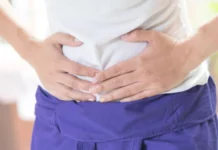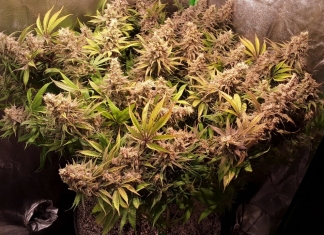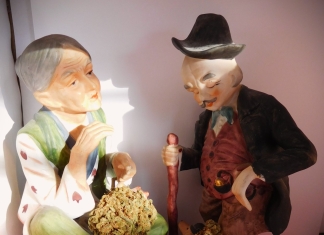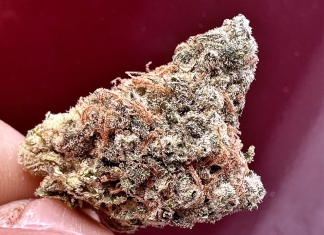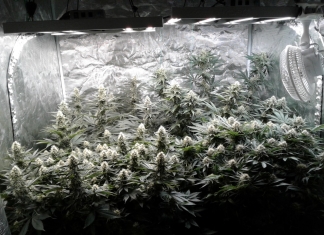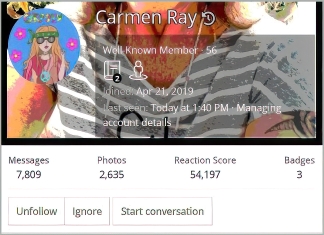American Review of Respiratory Disease, Volume 109, 1974, p. 420-428
By Donald P. Tashkin, Bertrand J. Shapiro, and Ira M. Frank
SUMMARY: The acute effects of smoked 2 per cent natural marijuana (7 mg per kg) and 15 mg of oral delta-9-tetrahydrocannabinol (THC) on plethysmographically determined airway resistance (Raw) and specific airway conductance (SGaw) were compared with those of placebo in 10 subjects with stable bronchial asthma using a double-blind crossover technique. After smoked marijuana, SGaw increased immediately and remained significantly elevated (33 to 48 per cent above initial control values) for at least 2 hours, whereas Sgaw did not change after placebo. The peak bronchodilator effect of 1,250 mcg of isoproterenol was more pronounced than that of marijuana, but the effect of marijuana lasted longer.
After ingestion of 15 mg of THC, SGaw was elevated significantly at 1 and 2 hours, and Raw was reduced significantly at 1 to 4 hours, whereas no changes were noted after placebo. These findings indicated that in the asthmatic subjects, both smoked marijuana and oral THC caused significant bronchodilation of at least 2 hours’ duration.
Introduction
In the nineteenth century, one of the medicinal uses of marijuana was in the therapy of bronchial asthma (1); however, no definite evidence of its effectiveness as a bronchodilator was adduced until recent studies demonstrated significant airway dilatation in healthy young men after both the smoking of marijuana (2,3) and the ingestion of its principal psychoactive ingredient delta-9-tetrahydrocannabinol (THC) (3). Whether similar effects could be elicited in subjects with bronchospastic disease was of interest because the irritant effect of marijuana smoke, which is probably responsible for the symptoms of bronchitis attributed to heavy or chronic marijuana smoking (4,5), might outweigh the bronchodilator properties of delta-9-THC, thereby resulting in bronchospasm in patients with hyper-reactive airways. Consequently, the acute effects of both inhaled marijuana smoke and oral delta-9-THC on specific airway conductance (SGaw) were investigated in a group of patients with clinically stable bronchial asthma.
Materials and Methods
Subjects: Five men and 5 women (from 22 to 74 years of age) with a diagnosis of bronchial asthma according to the criteria established by the American Thoracic Society (6) were studied. Each subject had a clinical picture characterized by typical episodes of wheezing, cough, and dyspnea occurring either spontaneously or in response to exposure to inhaled allergens or nonspecific irritants, to emotional aspects, to respiratory tract infections, and/or to exercise, and relieved by bronchodilator medication. At the time of study, all subjects were clinically stable; asthmatic symptoms were absent in 4 subjects and chronic and of mild to moderate severity in the remainder. With the exception of 2 subjects (PF and JBon), who probably had pulmonary emphysema in addition to bronchospastic disease, there was no evidence of other significant medical illness by history, physical examination, complete blood count, blood chemistries (SMA-12), routine urinalysis, electrocardiogram, and chest radiograph. Significant psychiatric illness was excluded on the basis of interviews with one of the investigators and evaluation of performance on lthe Minnesota Multiphasic Personality Inventory.
All subjects underwent screening pulmonary function studies, including spirometry using a 13.5-liter water spirometer (Warren E. Collins, Inc.), single-breath diffusing capacity for carbon monoxide (DLCO) (7), airway resistance (Raw), and thoracic gas volume (Vtg) using a 900-liter, variable-pressure body plethysmograph (8,9). To assess the degree of reversible airway obstruction, spirometry was performed both before and 10 minutes after inhalation of 0.25 ml of isoproterenol HCL (1:200) via a DeVilbiss nebulizer connected to a positive pressure breathing device powered by compressed air. The following technique was used to administer the isoproterenol aerosol. Subjects were instructed first to exhale to residual volume, then to inhale slowly from the nebulizer to total lung capacity during a period of approximately 10 seconds, and then to resume normal breathing for several seconds. These maneuvers were repeated until the bronchodilator solution in the nebulizer was consumed (usually after 4 to 5 deep breaths). In addition, Raw and Vtg were measured both 15 minutes before and immediately before inhalation of isoproterenol, and at 5, 15, 30, and 60 minutes after the bronchodilator. In all subjects, flows and/or SGaw (the ratio of the reciprocal of Raw to the simultaneously measured Vtg) increased more than 25% after isoproterenol inhalation, indicating the responsiveness of the airways to bronchodilator medication.
Seven of the 10 subjects had smoked marijuana previously, but only sporadically (less than 1 cigarette per month). None admitted to the use of drugs other than those prescribed for bronchial asthma, and none was a tobacco cigarette smoker. No subject had used marijuana within 7 days before the present study. In addition, bronchodilator medication was withheld for at least 8 hours before the study.
Experiments were carried out with each subject on 4 separate days beginning at 10 A.M., with at least 48 hours intervening between each study session. The subjects were informed that they would be randomly receiving marijuana or placebo.
Smoked marijuana: During 2 of the 4 experimental sessions, subjects smoked 7 mg per kg of body weight of natural marijuana preparation containing either 0.0 % delta-9-THC, serving as a placebo control, or 2.0 % delta-9-THC according to a random, double-blind crossover design; however, because of the potent psychotropic effects of marijuana, it was recognized that the subjects probably had little difficulty in identifying the marijuana. The THC content of the experimental preparation had previously been assayed by gas-liquid chromatography. The 0 % preparation was obtained by extraction of the active cannabinoids from the natural material until assays for cannabinol, cannabidiol, delta-8-THC, and delta-9-THC were all 0.0 %.
A uniform smoking technique was used in an effort to standardize the amount of volatilized delta-9-THC delivered in the inhaled material. Subjects inhaled the cigarette deeply for 2 to 4 seconds, held their breath for 15 seconds, resumed normal breathing for approximately 5 seconds, and then repeated these maneuvers until the cigarette was consumed, during a period of approximately 10 minutes. The cigarette butt, or “roach,” was held with forceps to permit nearly complete consumption of the “roach,” where the volatilized cannabinoids are concentrated.
The following characteristics were measured 15 minutes before and immediately before marijuana or placebo was smoked (initial control period) and immediately, 5, 10, 15, 30, 60, 90, 120, and 180 minutes after completion of smoking: Raw, Vtg, respiratory rate, heart rate (determined from the electro-cardiogram), and systolic and diastolic blood pressures. In addition, to provide a rough assessment of the degree of intoxication; at each interval after the smoking of marijuana and placebo, the 7 subjects who had had prior experience with Cannabis were asked to estimate how “high” they felt on a scale of zero to 7 in which 7 represented the “highest” they had ever felt after smoking marijuana.
Oral delta-9-THC: During the remaining 2 study days, after an overnight fast, according to a random double-blind design subjects ingested either placebo or 15 mg of synthetic delta-9-THC dissolved in sesame oil and contained in identical-gelatin capsules. Again, as in the smoked marijuana experiments, the subjects were probably able to identify the delta-9-THC because of the marked psychotropic effect. Measurements of the same characteristics as those determined in the smoking studies and scoring of subjective degrees of intoxication were carried out 30 minutes before and immediately before oral administration of the drug (initial control Period) and 30, 60, 90. 120. 180, 240, 300, and 360 minutes after ingestion. The order of the smoking and oral experiments was randomized among the study subjects.
All natural marijuana and synthetic THC preparations were obtained from the National Institutes of Mental Health, under whose direction all extraction, blending, assay, and synthetic procedures had previously been performed.
Results
From each set of measurements of Raw and Vtg, SGaw was calculated to correct for changes in Raw secondary to changes in lung volume (10). For each subject at each time interval after inhalation of isoproterenol or the smoking or ingestion of the test agent, per cent change in each of the measured characteristics was calculated from the average of the 2 control values. Individual per cent changes were averaged for each inhaled or ingested agent separately for all subjects at each time interval for each type of experimental preparation. Using the Student t test, significance of the differences between means was determined for (1) the average per cent change in each characteristic for each experimental preparation compared with initial control values, (2) the per cent changes that followed smoked marijuana and oral THC compared with placebo using paired observations, (3) the differences between the mean scores from zero for the levels of “high” after smoked marijuana and oral delta-9-THC. Physical characteristics and the results of the baseline pulmonary function studies for each subject are indicated in table 1. Although baseline forced expiratory volume in 1 second (FEV1) was greater than 80 % of the predicted value in 3 asymptomatic subjects (MA, SC, GT), in 2 of the latter SGaw was more than 2 standard deviations below the mean predicted value for this laboratory, and in the third subject, SGaw increased 87 % after isoproterenol inhalation, indicting the presence of reversible bronchospasm. There, symptoms and/or functional abnormalities were present in all subjects.
Average initial control values for the measured characteristics during each experimental session are indicated in table 2. There were no significant differences between the mean baseline values obtained on separate days.
Smoking studies: The average per cent changes in SGaw and Vtg after smoked marijuana, smoked placebo marijuana, and inhaled isoproterenol are shown in figures 1 and 2. After placebo, neither SGaw nor Vtg changed significantly. After 2 per cent marijuana, average SGaw increased immediately and remained elevated (33 to 48 per cent more than initial control values) for at least 2 hours. These increases were significant (P<0.05) compared both with control values and with placebo values.
The Vtg decreased slightly (4 to 13 per cent) but significantly (P<0.05) compared with baseline and/or marijuana. Changes in Raw after marijuana generally paralleled the changes in SGaw but were of lesser magnitude because of the associated decreases in Vtg.
For comparison with the changes that followed marijuana smoking, average per cent changes in SGaw and Vtg after inhalation of 1,250 mcg of isoproterenol are also shown in figures 1 and 2. During the first 15 minutes after inhalation of isoproterenol, SGaw increased to levels greater than those observed after 2 per cent marijuana. By 60 minutes after isoproterenol, SGaw was elevated only slightly, and was significantly less than the SGaw after marijuana (P<0.05). During the first 30 minutes after isoproterenol inhalation, Vtg was significantly reduced, to a degee similar to that noted after marijuana. By 60 minutes after isoproterenol, Vtg had essentially returned to normal.
The average percentage changes in heart rate after smoking of marijuana or placebo and after inhalation of isoproterenol are shown in figure 3. Pulse rate decreased gradually after placebo to levels that were slightly but significantly below baseline values after 30 to 120 minutes. After 2 per cent marijuana, pulse rate increased immediately and remained elevated for 30 minutes by amounts (7 to 22 Per cent) that were significantly different from the changes that followed placebo (P<0.05). Therafter, pulse rate decreased to levels that, at 90 and 120 minutes, were significantly below initial control values (P<0.05) but were not significantly different from the changes that followed placebo. Pulse rate increased after isoproterenol, but the increase was not significant at P<0.05.
No significant change in systolic or diastolic blood pressure or in respiratory rate was observed after placebo, marijuana, or isoproterenol. All subjects admitted to a definite feeling of intoxication after smoking marijuana, whereas all but one subject had either no change or minimal change in state of consciousness after placebo. The latter subject (PF), who had not had any previous exposure to Cannabis, felt sleepy, lightheaded, and jittery after both marijuana and placebo. The scores for subjective degree of “high” after marijuana revealed a maximal feeling of intoxication during the 5-minute period immediately after completion of smoking, with a gradual decline thereafter (figure 4). By 2 hours, the magnitude of the “high” was approximately one-third of the peak level, and by 3 hours, the “high” had essentially dissipated.
Oral studies: The results of the oral studies are shown in figures 5 and 6. The SGaw increased modestly (14 to 19 per cent) but significantly (P<0.05) at 60 to 120 minutes after ingestion of 15 mg of delta-9-THC, whereas the placebo was not associated with any significant changes. The Vtg did not change significantly after either placebo or THC.
As noted with smoked marijuana, decreases in Raw after oral THC paralleled the increases in SGaw, except that Raw was still significantly reduced (-10.2 + 3.6 and -12.9 + 3.3, with P<0.05) at 3 and 4 hours, respectively. No alteration in respiratory rate, pulse rate, or systolic or diastolic pressure was observed after oral delta-9-THC or placebo. A subjective “high” was first experienced 1 hour after ingestion of THC, reached a peak at 2 to 3 hours, then declined gradually, and was gone by 6 hours (figure 4). The placebo preparation was not associated with any significant change in consciousness.
Discussion
The significant increases in SGaw after the smoking of marijuana compared with placebo suggested that inhaled marijuana caused airway dilatation in asthmatic subjects and was consistent with findings previously reported in persons without airway disease (2, 3). The dilatation was not due to an increase in lung volume (10), because Vtg decreased significantly in paralled with the increase in SGaw. The observed decrese in Vtg was consistent with a reduction in air trapping secondary to the decrease in bronchomotor tone. Also, the volume history of the lung, i.e., the deep, sustained inhalation breathing pattern, did not explain the increase in SGaw that followed marijuana smoking compared to placebo smoking, because the breathing patterns were similar.
Because there was a significant correlation between the individual increases in SGaw after marijuana and the magnitude of the subjective “high” (r= 0.52; P< 0.01), the possibility that the observed bronchodilatation was causally related either to the psychologic effects of marijuana or to other effects of Cannabis on the central nervous system deserves consideration. Despite the significant correlation between the degree of marijuana-induced bronchodilatation and the level of intoxication, the time sequences for these changes were somewhat different, in that the bronchodilator effect at 2 hours was similar in magnitude to that noted immediately after smoking (figure 1), whereas by 2 hours the “high” had decreased to less than one half of the level experienced immediately after smoking (figure 4); however, these temporal differences did not exclude the possibility that the emotional changes experienced soon after smoking triggered a chain of reactions that eventuated in a relaxation of bronchomotor tone of longer duration than the initiating emotional stimulus.
A cause-and-effect relationship between the psychologic and bronchial effects of marijuana is consistent with the common clinical observation that asthmatic attacks can be triggered by emotional factors and by the demonstrated effectiveness of suggestion (13) and behavior therapy (14) in the relief or prevention of bronchospasm. On the other hand, the fact that significant bronchodilatation after 2 per cent marijuana has also been noted in nonasthmatic persons suggests that the dilator effect observed in our asthmatic subjects was probably at least not predominantly of psychogenic origin, because there is no evidence that bronchomotor tone in normal man is influenced significantly by emotional factors. Moreover, although 3 of our subjects who had had no previous exposure to Cannabis experienced a less euphoric “high” than the others there was no difference in the degree of bronchodilatation observed between these persons and those who had smoked marijuana previously, suggesting that the pleasure associated with the “high” was probably not related to the relaxant effect on the airways.
Although the mechanism whereby marijuana decreases bronchomotor tone has not been studied in asthmatic patients, previous work in this laboratory in normal subjects suggested that the bronchodilator effect is mediated neither by stimulation of B-adrenergic receptors nor by an atropine-like effect (15). These results make it appear unlikely that in normal persons the bronchodilator effect of marijuana is mediated by its effects on lthe central nervous system, and favor, instead, a direct effect of the drug on bronchial smooth muscle. This may also be true in asthmatic patients.
The fact that the smoking of placebo marijuana did not cause a significant decrease in SGaw ;was surprising because the inhalation of particulate matter in the smoke was expected to cause reflex bronchoconstriction by analogy with tobacco cigarette smoking (16), particularly in asthmatic subjects, whose airways are more reactive to nonspecific irritants than those of subjects without airway disease (17).
In the present study, the failure of the airways to constrict after smoked placebo might have been due to a balancing out of the constrictor effect of inhaled irritants either by unidentified bronchodilator compounds in marijuana that are not alcohol-extractable, or by a nonspecific placebo bronchodilator response to the expectation of a pleasant experience.
In a prior study, it was shown that the airways of normal subjects also did not constrict after the smoking of the placebo preparation but did constrict after cigarette smoking (3). The fact that pulse rate decreased after placebo, in contrast to the significant and expected increase (18) after 2 per cent marijuana (figure 3), suggests a placebo phenomenon rather than a pharmacologic response to a bronchodilator substance in the THC-extracted marijuana preparation.
Although the maximal mean change in SGaw after smoking of 2 per cent marijuana (48 per cent) was less than that after inhalation of 1,250 mcg of isoproterenol HCL (69 per cent), the bronchodilator effect of marijuana was more sustained than that of isoproterenol, consistent with the metabolism of delta-9-THC to physiologically active compounds (19), in contrast to the rapid conversion of isoproterenol to inactive metabolites (20).
The pharmacologic bronchodilator principal in marijuana might have been expected to produce a fractionally greater bronchodilator effect in subjects with bronchospastic disease compared with healthy subjects by analogy with the greater bronchodilator response to inhaled isoproterenol in asthmatic compared with normal subjects. Our observation that marijuana smoking resulted in a similar, rather than greater, magnitude of bronchdilatation in asthmatic subjects compared with that previously noted in normal persons (3) might possibly have been due to the following reasons. Although an attempt was made to standardize the technique of marijuana smoking, it is possible that the asthmatic subjects delivered less THC to their airways because of relative inexperience with the smoking technique compared with healthy chronic smokers; the bronchial irritant effect of marijuana smoke might have tended to produce more bronchoconstriction in subjects with hyper-reactive airways compared with normal persons, thereby offsetting a potentially greater fractional bronchodilator response to the pharmacologic agent (THC) in marijuana smoke in subjects with bronchospastic disease; because repeated exposure to marijuana is believed to lead to induction of enzymes needed to convert delta-9-THC to the active 11-hydroxy metabolite (19), less extensive metabolism of delta-9-THC to the active form in our asthmatic subjects with relatively little previous marijuana experience might have accounted for a lesser magnitude of physiologic effect than would have resulted had they been chronic users.
The maximal average per cent increase in heart rate after marijuana smoking in the present study was only 22 per cent as opposed to the 55 per cent increase previously reported in healthy, experienced subjects smoking the same quantity of THC (3). Possible explanations for this discrepancy in the magnitude of marijuana-induced tachycardia in asthmatic subjects compared with normal subjects include the following reasons: (1) the fact that our asthmatic subjects were relatively inexperienced marijuana smokers might have resulted in reduced delivery of marijuana smoke to the airways and, consequently, reduced systemic absorption of THC; (2) more uneven distribution of marijuana smoke and increased mucus and inflammatory changes in the tracheobronchial tree of asthmatic patients might have resulted in decreased or delayed absorption of THC from the airways; (3) there might have been less conversion of delta-9-THC to the active 11-hydroxy metabolite in our relatively naive asthmatic smokers; (4) there might be basic differences in myocardial tissue responsiveness to THC in asthmatic subjects compared with healthy persons.
The small but significant increases in SGaw and decreases in Raw after oral delta-9-THC indicated that this component of natural marijuana has a systemically active bronchodilator effect in asthmatic patients beginning 1 hour and lasting as long as 4 hours after ingestion of the drug; however, this bronchodilator effect was fractionally smaller in magnitude than that previously noted in normal subjects after the same dose of THC (3). Moreover, heart rate did not increase significantly (maximal mean increase, 9 + 5 per cent) after oral administration of 15 mg of delta-9-THC in our asthmatic subjects in contrast with the significant increases (19 + 7 per cent) previously noted in normal subjects (3).
These discrepancies in the responses to oral THC of normal experienced Cannabis users and relatively inexperienced asthmatic persons might have been due to differences in absorption of the drug from the gastrointestinal tract, metabolism of THC to the active agent, or tissue responsiveness. With regard to the first 2 possibilities, comparison of plasma concentrations of delta-9-THC and its metabolites after oral administration of the drug in both experienced and naive persons with and without asthma would be of interest.
We can conclude that in clinically stable asthmatic subjects with minimal to moderate bronchospasm, both smoked marijuana and oral delta-9-THC resulted in bronchodilatation lasting as long as 2 hours and 4 hours, respectively. Further studies to evaluate the effects of smoked marijuana and oral delta-9-THC on bronchomotor tone during spontaneous or experimentally induced asthmatic attacks would be of interest. Because only the acute effects of marijuana smoking on airway dynamics in subjects with bronchospastic disease were studied, the results did not preclude the possibility of an aggravation of existing bronchial pathology secondary to chronic marijuana smoking in these same persons. Furthermore, the profound psychotropic effect of marijuana and delta-9-THC, in addition to such side effects as tachycardia and the atropine-like drying effect, might severely limit any clinical therapeutic usefulness.
Acknowledgment
The writers are indebted to Dr. Stephen Szara, National Institutes of Mental Health, for advice in the experimental design of the study; to Dr. Daniel H. Simmons, for help in review of the manuscript; to Mr. Richard N. Bleich, Senior Pharmacist, for assistance in the double-blind aspects of the study, and to Mr. Enoch Lee and Mr. Charles Harper, for their invaluable technical assistance.
References
1. Grinspoon, L: Marijuana, Sci. Amer., 1969, 221, 17.
2. Vachon, L., Fitzgerald, M.X., Solliday, N.H., Gould, I.A., and Gaensler, E.A.: Single-dose effect of marijuana smoke. Bronchial dynamics and respiratory-center sensitivity in normal subjects, New Eng. J. Med., 1973, 288, 985.
3. Tashkin, D.P., Shapiro, B.J., and Frank, I.M.: Acute pulmonary physiological effects of smoked marijuana and oral delta-9-tetrahydrocannabinol in healthy young men, New Eng. J. Med., 1973, 289, 336.
4. Waldman, M.M.: Marijuana bronchitis, J.A.M.A., 1970, 211, 501.
5. Chopra, I.C., and Chopra, R.N.: The use of the Cannabis drugs in India, Bull. Narcotics, 1957, 9, 4.
6. American Thoracic Society: Chronic bronchitis, asthma and pulmonary emphysema, A statement on Diagnostic Standards of Nontuberculous Respiratory Diseases, Amer. Rev. Resp. Dis., 1962, 85,762.
7. Ogilvie, C.M., Forster, R.E., Blakemore, W.S., and Morton, J.W.: A standardized breath holding technique for the clinical measurement of the diffusing capacity of the lung for carbon monoxide, J. Clin. Invest., 1957, 36,1.
8. Dubois, A.B., Botelho, S.Y., and Comroe, J.H., Jr.: A new method for measuring airway resistance in many using a body plethysmograph: Values in normal subjects and patients with respiratory disease, J. Clin. Invest., 1956, 35, 327.
9. Dubois, A.B., Botelho, S.Y., Bedell, G.N., Marshall, R., and Comroe, J.H., Jr.: A rapid plethysmographic method for measuring thoracic gas volume, J. Clin. Invest., 1956, 35, 322.
10. Briscoe, W.A., and Dubois, A.B.: Relation between airway resistance, airway conductance and lung volume in subjects of different age and body size, J. Clin. Invest, 1958, 37, 1279.
11. Kory, R.C., Callahan, R., Boren, H.G., and Syner, J.C.: The Veterans Administration-Army cooperative study of pulmonary function. I. Clinical spirometry in normal men, Amer. J. Med., 1961, 30, 243.
12. Cotes, J.E.: Lung Function, F.A. Davis Company, Philadelphia, 1965.
13. Luparello, T., Lyons, H.A., Bleecker, E.R., and McFadden, E.R., Jr.: Influences of suggestionon airway reactivity in asthmatic subjects, Psychosom. Med., 1968, 30, 819.
14. Moore, N.: Behavior therapy in bronchial asthma; a controlled study, J. Psychosom. Res., 1965, 9, 257.
15. Shapiro, B.J., Tashkin, D.p., and Frank, I: Mechanism of increased specific airway conductance with marijuana smoking in healthy young men, Ann. Intern. Med., 1973, 78, 832.
16. Nadel, J.A., Comroe, J.H., Jr.: Acute effects of inhalation of cigarette smoke on airway conductance, J. Appl. Physiol., 1961, 16, 16 713.
17. Devries, K., Booij-Noord, H., Goei, J.T., and orie, N.G.M.: Hyperreactivity of the bronchial tree to drugs, chemical and physical agents, in Bronchitis, N.G.M. Orie and H.G. Sluiter, ed., Royal VanGorcum, Assen, Netherlands, 1964, p. 167.
18. Galanter, M., Wyatt, R.J., Lemberger, L., Weingartner, H., Vaughan, T.B., and Roth, W.T.: Effects on humans of delta-9-tetrahydrocannabinol administered by smoking, Science, 1972, 176, 934.
19. Lemberger, L., Axelrod, J., and Kopin, I.J.: Metabolism and dispostition of delta-9-tetrahydrocannabinol in man, Pharmacol. Rev., 1971, 23, 371.
20. Lyons, H.A., Ayres, S.M., Dworetzky, M., Falliers, C.J., Harris, M.C., Dollery, C.T., and Gandevia, B.: Symposium on isoproterenol therapy in asthma, Ann. Allerg., 1973, 311, 1.





